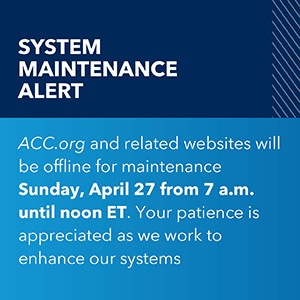Harmonization of ACC/AHA and ESC/ESH BP/Hypertension Guidelines
- Authors:
- Whelton PK, Carey RM, Mancia G, Kreutz R, Bundy JD, Williams B.
- Citation:
- Harmonization of the American College of Cardiology/American Heart Association and European Society of Cardiology/European Society of Hypertension Blood Pressure/Hypertension Guidelines: Comparisons, Reflections, and Recommendations. Eur Heart J 2022;Aug 11:[Epub ahead of print.]
The following are key points to remember from this article on the harmonization of the American College of Cardiology/American Heart Association (ACC/AHA) and European Society of Cardiology/European Society of Hypertension (ESC/ESH) blood pressure/hypertension guidelines:
- In 2017, the ACC/AHA guideline provided 106 formal recommendations for the prevention and management of elevated blood pressure (BP). In 2018, the ESC/ESH published a related guideline with 122 recommendations. While the guidelines provide similar recommendations in many respects, areas of difference exist.
- A major source of BP misclassification is due to measurement errors. Both guidelines emphasize the accurate measurement of BP using validated devices and multiple readings. ACC/AHA recommends averaging office reading for ≥2 readings using the same device on ≥2 occasions. ESC/ESH recommends three office measures with an additional reading if two of the readings differ by >10 mm Hg. Both guidelines recommend home BP monitoring or ambulatory BP monitoring (ABPM) measures to confirm elevated BP and diagnosis of masked or white-coat hypertension.
- BP targets are somewhat lower in ACC/AHA than ESC/ESH guidelines, especially in older adults and those with chronic kidney disease (CKD). The ACC/AHA includes categories for normal BP (<120/80 mm Hg), elevated BP (120-129/<80 mm Hg), and two stages of hypertension, stage 1 (130-139/80-90 mm Hg) and stage 2 (≥140/≥90 mm Hg). The ESC/ESH classifies BP into optimal BP (<120/<80 mm Hg), normal BP (120-29/80-84 mm Hg), high normal BP (130-39/85-89 mm Hg), three grades of systolic/diastolic hypertension (starting at 140/90 mm Hg), and isolated systolic hypertension. It retains the same systolic BP (SBP) ≥140 mm Hg and/or diastolic BP (DBP) ≥90 mm Hg cut points for diagnosis of hypertension recommended in the preceding 2013 ESH/ESC guidelines. Additional cut points exist for home BP and ABPM in both guidelines.
- The ESC/ESH takes a more stepped approach, first recommending achievement of an SBP/DBP <140/90 mm Hg before targeting a lower BP. The ESC/ESH identified a SBP of 120 mm Hg and a DBP 70 mm Hg as the lower safety boundary for BP reduction in adults 18-65 years of age, with 130 mm Hg in those with CKD. On the other hand, the ACC/AHA recommends a single SBP/DBP target of <130/80 mm Hg in most adults, but SBP <130 mm Hg in older well adults if tolerated.
- Both guidelines recommend cardiovascular disease (CVD) risk assessment to aid in decisions for BP management and initiation of antihypertensive medications. The ACC/AHA recommends assessment of atherosclerotic CVD (ASCVD) risk using the Pooled Cohort Equations with >10% risk considered high risk. For adults <40 years of age, the ACC/AHA recommends the estimation of lifetime CVD risk. In the ESC/ESH guidelines, adults with existing CVD, including asymptomatic atheromatous disease on imaging, type 1 or 2 diabetes mellitus, very high levels of individual CVD risk factors, or CKD are considered to be at high or very high risk (10-year CVD mortality of 5–10% and ≥10%, respectively). For all others, 10-year CVD mortality risk should be estimated using the Systematic Coronary Risk Evaluation (SCORE) risk estimator. The SCORE risk is estimated using a patient’s age, sex, total cholesterol or total and high-density lipoprotein cholesterol, smoking status, and level of SBP.
- The ACC/AHA guideline recommends antihypertensive medication for SPB ≥140 mm Hg or DPB ≥90 mm Hg irrespective of ASCVD risk. Drug therapy is also recommended for adults at high risk for ASCVD and SBP 130-30 mm Hg or DBP 80-89 mm Hg. ESC/ESH recommends target ranges but recognizes that the optimal and tolerated targets for individuals will differ. The initial SBP/DBP target is <140/90 mm Hg for all adults with hypertension. Provided the treatment is well tolerated, targeting 130/80 mm Hg is recommended, with subsequent efforts to achieve a lower BP in those 18-65 years of age. The ESC/ESH recommends 3 months of lifestyle modification for patients with a low or moderate risk for CVD, only then if BP is not controlled (i.e., SPB ≥140 or DPB ≥90 mm Hg) to start antihypertensive medication. The exception for these cut points in the ESC/ESH guidelines is for adults >80 years; medications are recommended when office SBP is ≥160 mm Hg.
- Both guidelines emphasize lifestyle modification for the prevention and treatment of elevated BP. In a high percentage of adults, elevated BP is related to an unhealthy diet, lack of physical activity, and/or use of alcohol. Both guidelines address adherence and recommend single-pill combinations to improve adherence and reduce therapeutic inertia. However, no specific class of antihypertensive is recommended. The ACC/AHA recommends combination therapy for most patients and specifically African Americans. Simultaneous use of angiotensin-converting enzyme inhibitor and angiotensin receptor blocker is potentially harmful.
- Treatment of other CVD risk factors is recommended in both guidelines, but ACC/AHA references other ACC/AHA guidelines for specific details, whereas ESC/ESH includes details for statin and aspirin therapy.
Clinical Topics: Cardiovascular Care Team, Diabetes and Cardiometabolic Disease, Dyslipidemia, Geriatric Cardiology, Prevention, Vascular Medicine, Lipid Metabolism, Nonstatins, Novel Agents, Statins, Hypertension, Smoking
Keywords: Angiotensin Receptor Antagonists, Angiotensin-Converting Enzyme Inhibitors, Atherosclerosis, Antihypertensive Agents, Aspirin, Blood Pressure, Blood Pressure Monitoring, Ambulatory, Cholesterol, Diabetes Mellitus, Geriatrics, Hydroxymethylglutaryl-CoA Reductase Inhibitors, Hypertension, Life Style, Lipoproteins, HDL, Primary Prevention, Renal Insufficiency, Chronic, Risk Assessment, Risk Factors, Sedentary Behavior, Smoking, White Coat Hypertension

